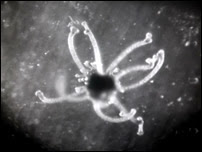Jean Painlevé y sus tomas submarinas.

Estudió biología (después de abandonar medicina). Adaptó la cámara para filmar debajo del agua. Sin su extrema curiosidad de niño, yo nunca hubiera podido tomar esta foto, en mi más fuerte reencuentro con el mar, con una cámara desechable (creo que jamás se lo pudo haber imaginado). Además de desarrollar lentes microscópicos y adaptaciones para filmar con cámara lenta o rápida.

Painlevé hace un breve recorrido de la vida de ciertos animales subacuáticos. En todos prácticamente pasando por alimentación y reproducción. Acompañados siempre de música que según lo que he leído causó controversia.
"Specialist audiences were scandalised by the soundtracks to Painlevé's films – presumably, to Painlevé's own considerable delight. The Vampire – Painleve's exploration of the vampire as a biological archetype and his cheerfully morbid allegory for nazism – is enlivened by Duke Ellington's 'Black and Tan Fantasy' and 'Echoes of the Jungle'. Painlevé's fascination for octopi was as great as his partisan tastes for experimental music, and both are brought into compelling relief for his Love life of the octopus. The score for this film was commissioned from the French pioneer of musique concrete, Pierre Henry; and Henry's sonorities are delicately matched to the action transpiring on the screen. If only a small part of Love life of the octopus is devoted to the inconceivable erotica of amorous octopi, through the fluid grace of an eight-arm embrace and the silken glance of an inscrutably bulbous eye those sequences are rendered genuinely erotic. Henry's music would've been incongruous in most other cinematic contexts, but in this film his early electronica is perfectly matched to the stunning grotesquerie of the image.

For Painlevé, these soundtracks were a means of enhancing the popular appeal of films expressly intended for a wider audience: but this music also functions as an "irrational enlargement" of aquatic gestures framed in the camera lens. Back on shore, a fascination for the gestural logic of naked, animate instinct culminates also in L'Ecriture du mouvement (A Notation for Movement, 1949) – a graphic notation of human dance movements. Painlevé raucously investigates the abundantly visible strangeness of all these animals, and this marriage of sound and image is a festive celebration of natural history's most unlikely menagerie.

Este hombre no era nada más un científico, era un artista y un explorador; de medios y elementos.


Su casa se volvió punto de reunión entre los intelectuales, donde solía encontrarse a personajes como Boiffard, Prévert, Eli Lotar y Alexander Calder. Más adelante colaboró con Ivan Goll en teatro y lo apoyó para el lanzamiento de la revista Surrealismo.
He puesto dos links. El primero es sobre un Pulpo, aunque no termino de entender muy bien qué es aunque he buscado información por todas partes. Y el segundo "Le Vampire", que había sido un "encargo" de parte del Pasteur Institute en Paris, pues tenían animales recién adquiridos, entre ellos el murciélago Brasileño. Painlevé aprovecha para hacer una metáfora con el Nazismo; nota que antes de irse a dormir el murciélago extendía las alas, como el saludo "Heil-Hitler". (Journal of Film Preservation)
Creo que la belleza de las películas de Painlevé, está en haber hecho poesía y ciencia. Películas para científicos y películas poema. Dos aproximaciones a un tema tan completamente distintas (y a ratos opuestas, o parecería) se ven sincretizadas en Science is Fiction. "Una manera de presentar la ciencia (...) de un hombre fascinado por el detalle ". Me conmovió hasta el último hueso del pié.

Recién me encuentro con una lista de los 10 mandamientos según él, en la página de Criterion.
1. You will not make documentaries if you do not feel the subject.
2. You will refuse to direct a film if your convictions are not expressed.
3. You will not influence the audience by unfair means.
4. You will seek reality without aestheticism or ideological apparatus.
5. You will abandon every special effect that is not justified.
6. Trickery will be of no use unless the audience is your confidant.
7. You will not use clever editing unless it illustrates your good intentions.
8. You will not show monotonous sequences without perfect justification.
9. You will not substitute words for images in any way.
10. You will not be content with “close enough” unless you want to fail spectacularly.
Evidentemente todo lo que vemos tiene que venir de un hombre con principios. Si se estudia la vida, hay que serle fiel. Painlevé es un caballero.

http://www.cinemathequeontario.ca/shortprogdetail.aspx?spId=1595
http://www.biografiasyvidas.com/biografia/p/painleve_jean.htm
http://archive.sensesofcinema.com/contents/03/25/painleve.html
http://www.guardian.co.uk/film/filmblog/2009/jun/03/submarine-cinema-paul-painleve
http://www.tcm.com/movienews/index.jsp?cid=238938
http://www.criterion.com/current/posts/1099




Ya soy un Fan de tu blog, te felicito.
ResponderEliminarPedro
por cierto, muy bella tu fotografía de la tortuga
ResponderEliminar